If the Microphone on your iPhone is not working, you won’t be able to use native apps like Phone, FaceTime and also third-party apps like WhatsApp to make voice and video calls.
There could be a variety of reasons for Microphone not working on iPhone, ranging from the simple case of the Microphone being blocked by an ill-fitting iPhone cover to software and settings related issues,
Microphone Not Working on iPhone
The main Microphone of iPhone is located at bottom of the device, near the charging port or lightning connector and these are used during regular phone calls.
Apart of these, iPhone is equipped with a Microphone located at top of the screen (near the ear-piece speaker) and another Microphone located at back of the device (near the rear-facing camera lens).
The Front-microphone is used during FaceTime calls, front camera video recording and for voice commands to Siri. The Rear-microphone is used for noise cancellation during phone calls and video recordings.
Now, that you are familiar with the placement of Microphones on your iPhone, let us go ahead and take a look at the steps to fix the problem of Microphone not working on iPhone.
1. Check iPhone Cover
If you are using a third party cover, make sure that the cover fits your device properly and it has the right openings to match the location of Microphones on your iPhone.
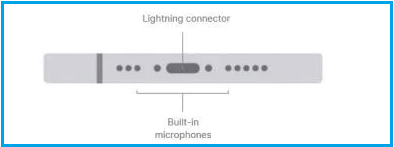
Source: Apple
The openings at the bottom of the cover need to be perfectly aligned and not covering or blocking the microphone in any way.
2. Clean Microphones
If your iPhone is suffering from muffed or low voice, the problem could be due to one or more of its Microphones being blocked by dirt or dust particles.
You can use any soft brush or a toothbrush to clean the top, bottom and the rear microphone on your iPhone.
Make sure you are not using excessive force or pressure while cleaning. Also, do not try to insert a toothpick or any other sharp object into the microphone.
3. Restart iPhone
Sometimes, the problem is due to stuck processes and unexplained minor glitches. This can be fixed by res
1. Go to Settings > General > Shut Down.
2. On the next screen, Power OFF iPhone by moving the Slider to right.
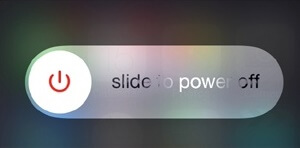
Allow iPhone to completely Power OFF > After 30 seconds, restart iPhone by pressing the Power button.
4. Allow Apps to Access Microphone
If you are facing problems while using WhatsApp, Skype or FaceTime, the problem is usually due to these VOIP Apps lacking the permission to access the Microphone on your device.
1. Go to Settings > Privacy & Security > Microphone.
2. On the next screen, Enable Microphone Access to the required App.
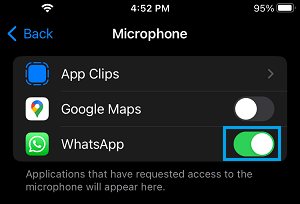
After this, make a call using the VOIP App that you were having problems with and check if the Microphone is now working.
5. Disconnect Bluetooth Devices
The problem could be due to iPhone being connected to AirPods, Wireless headphones, Car’s infotainment system or to External Bluetooth speakers.
1. Go to Settings > Bluetooth > disable Bluetooth.
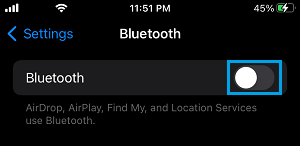
2. If you do not want to turn OFF Bluetooth, you can individually disconnect Bluetooth devices connected to your iPhone by tapping on the i icon located next to the Bluetooth device.
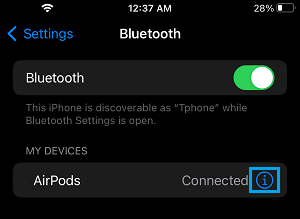
6. Update iPhone
Make sure iPhone is up to date with the latest Software updates.
1. Go to Settings > General > Software Update.
2. Wait for iPhone to check for updates > tap on Install (if an Update is available).
7. Disable Noise Cancellation
Noise Cancellation is enabled by default on iPhone, in order to reduce ambient noise while the user is holding the receiver to the ear.
While this works well in most cases, it can have an adverse impact on voice quality, if you are using iPhone in speaker mode and lying on a couch or bed while speaking.
1. Open Settings > Accessibility > scroll down and tap Audio/Visual.
2. On the next screen, switch OFF Noise Cancellation.
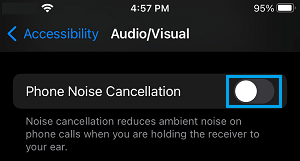
After this, call someone to check if the microphone is now working properly. If not, make sure you re-enable Noise Cancellation.
8. Reset All Settings
If above methods did not help, you can try to Reset All Settings on your iPhone to Factory Default Settings and see if this helps in fixing the problem.
1. Go to Settings > General > Transfer or Reset iPhone > Reset.
2. On the pop-up, select Reset All Settings option.
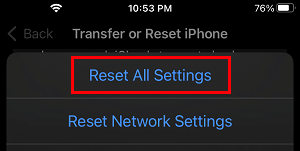
3. Follow the instructions to complete the Reset Process.
After the Reset Process is completed, you may find the Microphone working properly.
9. Check If Microphone Is Working
You can check the Front Microphone by recording a short selfie video and check the rear Microphone by recording a video using the main or the back camera on your iPhone.
To check the bottom Microphone, open Voice Memo App on your iPhone and record a short voice note holding the bottom microphone close to your mouth.
If the voice is cracking, fading or breaking in any of these videos, you need to get the Microphone on your iPhone examined by Apple Support or any other trained technician.